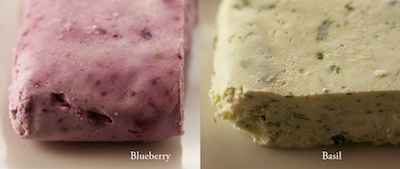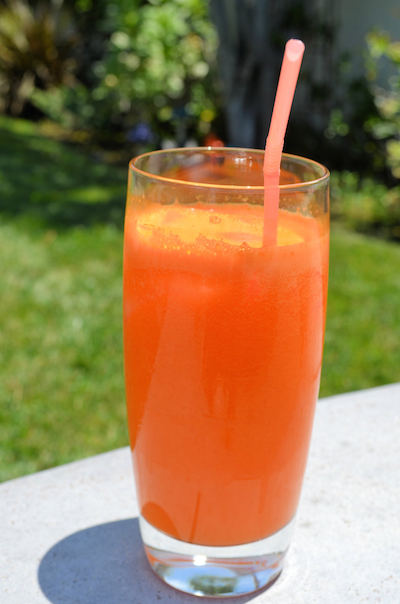New Tips for Tricks for Healthy Juicing

Recent studies have shown that juicing is one of the easiest ways to get all the recommended servings of nutritional fruits and vegetables daily, but ONLY if you are juicing the correct way. Juicing expert, Daniel Winer, recently created new simple tips and tricks for correct,healthy juicing.
“There are definitely some do’s for juicing that will make it easier and good for you. Below are some of my tips and tricks:

Save your pulp is a new tip for juicing. Juicing creates a lot of pulp but you don’t need to throw it away. There are many recipes from cream cheese, sorbets, sauces, soup and much more., has a few favorite that add a unique, nutritional twist to cream cheese:
Makes 1 serving
1/4 cup plain cream cheese
Pick your flavor!
Blueberry Cream Cheese
10 blueberries for 1 tbsp. blueberry pulp
Basil Cream Cheese
¼ cup fresh basil for 1 tbsp. basil pulp
Orange Almond Cream Cheese
½ large orange for 1 tbsp. orange pulp
1tbsp. crushed almonds
Strawberry Cream Cheese
5 Strawberries for 1 tbsp. strawberry pulp
Directions:
Remove cream cheese from the refrigerator and allow it to warm to room temperature.
Choose which cream cheese flavor you’d like, press the ingredients and gather the pulp. (Juice may be discarded or store in an airtight container for future use).
Whip cream cheese until it becomes soft and pliable. Stir in pulp and any additional ingredients.
Top your bagel and serve!
Tip
Juice basil with a bit of water to allow easier pressing and quicker clean up.
Think outside the ‘typical’ juicing box: Healthy foods that can be juiced in addition to the more common, trendy vegetables and fruits include Aronia Berry, Celeriac, Holy Basil, Peppadew Peppers and sunchokes.
Studies show that drinking juice in the morning (on an empty stomach and alone – at least half an hour before a meal) is the most beneficial time of day to have fresh juice when your stomach is empty and hungers for food, Since pressed juice has no fiber, there is nothing standing in the way of the pure nutrients being absorbed directly through the stomach and entering the bloodstream. As a general rule, keep fruit juices in the first half of the day, or at the start of your day as it provides the complex carbohydrates to fuel energy. For the later part of the day, drink juices that are less sweet, like partial or full green juices to avoid a potential sugar crash. Drinking juice in the evening or anytime is still beneficial.
My favorite morning juice because it has a zingy taste really wakes up your senses and gets you going! This juice is a nutrition dream. It contains Vitamins A and C, and in plentiful amounts. There are about 225 calories in this recipe and it contains over 100% RDA of both vita A and C.
The Sunrise Surprise
1 medium pink grapefruit, peeled
1 small apple
3 carrots
1/2 inch fresh ginger
1/2 small lemon (peeled)
Don’t juice too sweet, which tends to happen because people tend to juice a lot of fruit that are high in sugar. The best juicing recipes for overall health should always include cruciferous vegetables. These give your body the tools it needs to fight against xenoestrogens. Pushing detoxification in the right direction and helping with hormonal balance, cruciferous vegetables are the key to help you lose weight.
Juice consistently/ avoid juice cleanses. One juice once in a while is not going to be your silver bullet to health. If a juice is delicious, you’ll find you are much more likely to drink it again. My solution, pick one fruit you love and mix it with a solid base of green vegetables. The fruit will sweeten the taste and cut the “green” flavor of your juice. I recommend keeping the ratio of greens you juice much higher than the fruit. Or keep it entirely green especially if weigh loss is a goal. Instead of juice cleansing make juicing just a part of your lifestyle.
Merits of Cold-pressed juicers vs. centrifugal juicer vs. store bought juice
Store bought: juice can get expensive, with bottle often costing upwards to $10 a bottle. The biggest difference between store bought juices and juicing at home is pasteurization. Most conventional store-bought juices take six to 12 months from ‘juicing’ to pasteurization, then storage, juices can sit on a shelf for weeks which they lose all nutritional value.
Centrifugal Juicers use such high speed to extract their juice that the heat from the juicer often kills the enzyemes and vitamins in your fruit and veggies. They use sharp blades (that can be dangerous) and mesh that is often a pain to clean and has many parts.
Cold-press juicers extract juice by first crushing and then pressing fruit and vegetables for the highest juice yield up to 40% more juice. Because they don’t produce as much heat, they keep more of the fresh ingredients’ nutrients intact and keep juice fresh for up to three days.

 Gerry Furth-Sides
Gerry Furth-Sides  Barbara Hansen
Barbara Hansen  Chef-owner Alain Cohen
Chef-owner Alain Cohen  Roberta Deen
Roberta Deen  Jose Martinez
Jose Martinez  Nivedita Basu
Nivedita Basu